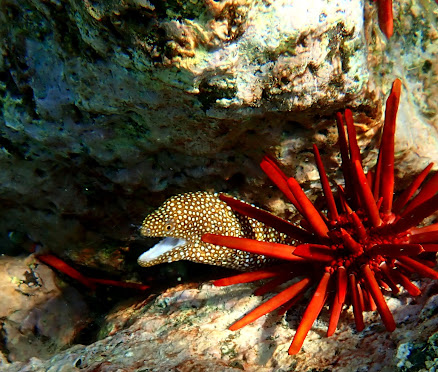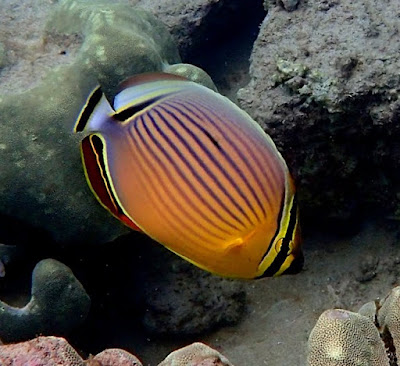As this year we had a social event scheduled for Christmas Day, I decided that I could start looking for the Christmas Wrasse on Christmas Eve. We would look at Kahalu'u iin the morning and if that failed, consider an afternoon swim on Paul Allen's Reef. And so, at 8:00 AM sweetie and I were on the final approach to
 |
| Raccoon Butterfly Christmas Eve 2021 Kahalu'u |
Undeterred by a high tide and waves, I was soon in the water, along with a surprisingly large number of fellow snorkelers, most of which were (and I'm not too good at this) Chinese. Despite appearances to the contrary, the water was only a little bumpy and had very little in the way of adverse current. Not terribly cold, it was more than a little cloudy.
While the lack of clarity was unfortunate, it was offset by a fairly large number of fishies. You may recall that when Sandra and I made our preparatory swim a week ago, the paucity of finned friends was depressing. Or to put it in seasonal jargon, our spirits were not bright.
 |
| Threadfin Butterfly, Christmas Eve 2021 |
I saw nothing spectacular until I got over by the Rescue Shelter. In some clearer water I snapped photos of raccoons, threadfins and a stocky hawkfish, who was pretending that I couldn't see him. Then, in the murky water, among the submerged pahoehoe, I saw a familiar twisting fish. I approached rapidly and nabbed a good five second look at an adult Christmas Wrasse. Despite the cloudy water, I enjoyed his bright, adult coloration. Of course, by the time I got the camera out he was long gone; no amount of swimming among the wave splashed rocks could bring him back.
And so, with the annual mission accomplished I swam along the rocky shallows, This is not the most handsome portion of Kahalu'u Bay, but it may be the most productive in relation to unusual animals. I've seen pearl wrasse, octopus and a leaf scorpionfish over in this corner in the recent past, so I always give it a special look. This time I was surprised to see a fleshy invertebrate clinging to one of the rocks.
The animal was long and skinny with a pair of blunt rhinophores leading him over the rock. I watched him for a couple minutes, certain that I had found a new species of nudibranch, or some similar mollusc. There was one puzzling aspect of this wannabe nudibranch, I could detect no external gills, which as you will recall, sprout from the after the third on the dorsal side of any self-respecting nudi, often in a colorful, feathery array. I took my photographs and began composing my letter to distinguished authorities.
 |
| Not a Sap Sucking Sea Slug |
Right in mid-paragraph, I was interrupted by the appearance of a juvenile Christmas Wrasse. This time, from the stand point of documentation, I had the camera in my hand. His coloration was subdued, as befits his lowly station in the Yuletide pageant, but, as you can see, there was no mistaking that the Baby Jesus had given us a second Christmas Wrasse with which to celebrate his special day. Hosanna in the highest!
You may wonder why I didn't have the camera in my hand when I saw the first Christmas Wrasse. Well, I've gotten old and sometimes I need both hands to swim. Not only that, but ever since I fell off the bleachers at Colsen's baseball game last September, I have been more cautious about bipedal locomotion. Luckily, as I hit the beach, one of the Chinese snorkelers was there to give me helping hand over the rocks. Shay shay.
 |
| But an Automatized Starfish Arm! |
Even though it was Christmas Eve, the Reef Teachers were there to provide whatever it is that they do. I spoke to an earnest young man named Chris, who produced a well-thumbed copy of John Hoover's critter book. We looked at my pictures on the camera and compared them with those in the book. In this manner, we found something like a nudibranch called a sap sucking slug ( you can't make up shit like this!) which didn't have obvious external gills. Chris and I left the book open to the sap sucking slug page, in hopes that Kathleen Clark soon would be there.
Following this bit of research, I put my finger beside my nose and Sandra and I, up the highway we rose.
Once we were safely ensconced in Casa Ono, warmed by several layers of fleece and a cup of hot cocoa, I processed my pictures and sent off letters to my three consultants, John Hoover, Pauline Fiene and a professor who will remain un-named. These were wonderful letters, warm with anticipation and holiday cheer.
John Hoover wrote back first, saying, "Jeff, I don’t think it’s a mollusk, but rather the automatized arm of a starfish! Probably Linckia multifora. You can see how it’s just beginning to grow a couple of new arms at the closer end. Let me know what the others think. May your starfish be merry and bright! — John
 |
| A juvenile Christmas Wrasse on Christmas Eve 2021 |
Suffice it to say, this was interesting, if somewhat deflating, news. What I had assumed were blunt rhinophores were actually a matched pair of developing starfish arms. Bummer.
Upon receiving the news from the Great Oz, Sandra grabbed the critter book and found John's piece on Linkia starfish. As it turns out, these starfish do something to make an arm self-sufficient..they "automatize" the arm...and then shed it. At this point the arm, hard as this is to believe, becomes a self sufficient animal. It crawls over the sea bed and digests algae through its tube feet, which in this automatized state now have a digestive function. And, it begins to grow four more arms.
If this sounds a bit like a zombie movie, I suggest you go out to
Forks, Washington, book a table at the Vampire Bar and Grill and order
the starfish arm special. As long as you don't look like algae, I believe you will be safe.
Pauline wrote back in a bit confirming John's identification, including a heart warming Christmas greeting. My professor, who will remain nameless, wrote back a bit later, saying she had never seen anything like that in her entire life. Now please pass the eggnog.
Once upon a time, John Hoover wrote that if you wanted to picture an alien, you could do worse than envisioning an echinoderm. And with those sage words, Sandra and I bid you all a Merry Christmas.










































